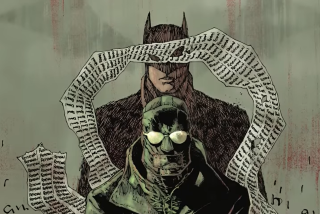Yes, it’s OK to have comic books in class
- Share via
CINCINNATI -- As a fine arts graduate student in the early 1980s, Carol Tyler felt she had to hide her interest in cartoon drawing from teachers. An art form associated with comic books and comic strips wasn’t considered college material.
Now a professional cartoonist and graphic novelist, Tyler began teaching the University of Cincinnati’s first comics art class last year.
Other colleges have also started such classes, as critical and academic respect for comics has grown. Courses that began in 2005 at the University of Alaska Fairbanks are starting to draw professional artists and public schoolteachers. Monroe Community College in Rochester, N.Y., will start its first course this spring.
Applications have increased by at least 50% at the Center for Cartoon Studies in White River Junction, Vt., which was founded two years ago and won state approval this year for a master in fine arts degree
“Schools are now recognizing the creative and commercial value of comics,” Tyler said as she watched students outline their pencil drawings in ink, filling in sections with black or gray tones. “An interest in comics and cartooning doesn’t have to be a secret any more.”
Some students hope to learn skills useful for advertising, film, video game or illustration careers. Some just enjoy comics; others want to produce comics or graphic novels.
“I started drawing comics when I was about 12, but had sort of put it aside,” said Mariana Young, 25, who wants to be a professional cartoonist and produce a one-character series to be published quarterly.
Tyler’s students learn graphic design, composition, lettering, layout and how to draw figures that convey emotion. She also tries to show them how to organize their thoughts to deliver clear and concise ideas. Story lines have included the impact of nannies on a student’s life and recollections of a colorful grandfath- er.
The director of the National Assn. of Comic Art Educators, Ben Towle, said it’s too soon to have hard data on numbers or where new classes are being taught. But the association is fielding many more inquiries about starting classes.
“There are a lot of scattershot courses as opposed to dedicated programs, but you wouldn’t even have seen that five years ago,” he said.
Demand also is growing for established courses, and some schools have waiting lists to take classes.
The number of freshmen in the cartooning major at the School of Visual Arts in New York more than doubled from 2002 to last year. The Savannah College of Art and Design in Georgia offered comics art in 1992 as an elective to a handful of students. The school now has nearly 300 undergraduates and 50 graduate students pursuing bachelor’s and master’s degrees in sequential art, also known as comics art.
Much of the credit goes to the emergence in the 1980s of graphic novels offering more complex and complete story lines for more mature audiences. They typically are more durably bound and longer than the floppy comic magazines that told the tales of Superman or the antics of small-town teenager Archie Andrews and friends.
Even traditional superheroes gradually have shown a darker, more personal side appealing to older readers. Many of those series have been collected into more colorful book formats and marketed as graphic novels.
But the young haven’t lost interest.
More high schools and even grade schools are seeking advice on ways to foster student interest in cartooning, said Michelle Ollie, managing director at the Vermont school. The center has had to add a second section to its pre-college workshops to accommodate demand.
The graphic novel’s increased critical acclaim and greater visibility in mainstream bookstores and libraries have contributed to the growing respect for comics art. Educators also cite the worldwide popularity and influence of Japanese comics known as manga -- written for children and adults -- and the transformation of graphic novels such as “Ghost World” into Hollywood films.
Schools have seen dramatic increases in the number of female students, attributed largely to manga and graphic novel themes that include romance, historical drama, autobiography, fantasy and mystery.
More schools also are studying comics as literature or creative writing in English departments. And although art educators and students say academic prejudice still exists, there are more academic conferences on comics, and libraries are increasingly carrying comic works.
“With graphic novels and manga, librarians have seen an upsurge in demand the last three to five years and many say manga is their highest circulation material,” Ann Kim, special projects and graphic novels editor for the Library Journal, said. “There is definitely more respect now.”
The comics publishing industry has grown with the broader range of comic types and outlets. Dark Horse Comics’ sales were primarily through the comic book specialty market for years, but now about half of sales are through bookstores, Diana Schutz, a Dark Horse executive editor, said.
John Lowe, chairman of Savannah’s sequential art department, thinks budget concerns have kept some schools from moving faster to add comics art courses.
“But with schools beginning to realize that comics aren’t just for juveniles and more students wanting this, I believe we’ll see comics art classes opening up like wildfire in the next five years or so,” Lowe said.
University of Cincinnati student Danielle Mahar, 21, who is leaning toward a book illustration career, credits Tyler’s class with winning her a job illustrating a children’s book.
“People have grown up with comics, but they don’t realize just how much work and time go into them,” Mahar said. “It’s an art that’s been unappreciated for too long, but that’s all starting to change.”
More to Read
The biggest entertainment stories
Get our big stories about Hollywood, film, television, music, arts, culture and more right in your inbox as soon as they publish.
You may occasionally receive promotional content from the Los Angeles Times.










